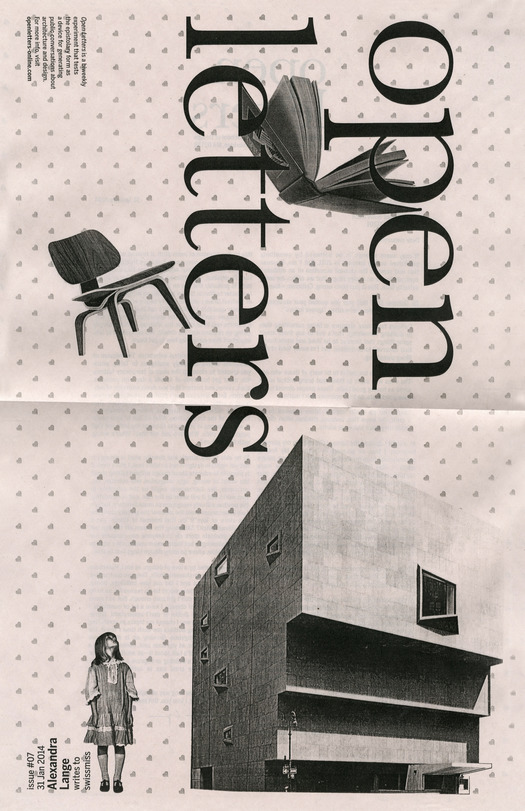
Open Letters is a print experiment that tests the epistolary form as a device for generating conversations about architecture and design. The publication was launched in September 2013 by students at Harvard's Graduate School of Design. In preparation for the February 14 GSD symposium, What criticism?, I wrote the following letter to Tina Roth Eisenberg, a.k.a. swissmiss. It was published January 31.
Dear swissmiss:
It may seem strange to be bothered by something published on the internet in 2011. But I am, because that text remains the clearest evocation of an attitude I continue to see on design blogs: that we critics are motivated by hate. This is just plain wrong. Criticism = love.
On October 17 of that year you quoted your studiomate Chris Shiflett under the heading, “Ignore haters”:
I always take more pleasure in liking something than in disliking something. That’s not to say there aren’t some things that deserve to be liked and some things that deserved to be disliked, but I’m never fond of disliking something.
The lesson I’ve learned is to be wary of those who are. The ones who seem to think that being critical is the same as having good taste. Those people almost never have good taste, so their opinions don’t matter.
There’s no particular sophistication required to be a critic. We know this, because children often dislike foods they learn to love as adults.
As a child I disliked the Eames LCW chair in my parents’ bedroom. I took no pleasure in hating it. My feeling separated me from my mother, whose taste I have always admired. Was Eames a flavor I had to become more sophisticated to enjoy? Perhaps. But that dislike, that gap between us in taste, fueled a productive thought process. I had to figure out what was so great about an object so ugly, so bulbous, so unlike the other (normal) chairs in our house. I had to learn about the Eameses, about bentwood, about cleaning up “the slum of legs.” If at the end of that process I still hated the chair, would I have gained less in sophistication? I learned to love the exploration. I love the chair too, even though, due to its age and the innovative industrial means of its manufacture, it is now sculpture rather than furniture.
All my life, criticism has been a gift. Literally. My mom gave me the Eames chair a few years ago. I can wave at it from the desk at which I’m typing.
In high school my mother gave me the collection of Ada Louise Huxtable’s essays, Kicked A Building Lately?, as an example of what writing about architecture could achieve. The reflected skyline on the cover. The pithy comments within, which hardly required illustration. The rhythm of seeing and thinking and writing. It felt fast and it felt just. Can’t you imagine Huxtable as Lois Lane, kicking the steel corners of the nascent Park Avenue School of Architecture? It’s true, she didn’t make the buildings. But, just like Lois, her reporting separated the real Supermen from Bizarro. Her words shaped what came next for New York. She made up names for what was happening to the city and to culture. By naming, she created an arena in which discussion could occur.

Your blog is clearly a critical enterprise. The mission of swissmiss seems obviously analogous to Tattly, which you created to clean up the slum of temporary tattoos. You must get hundreds of emails a day with products, apps, videos and posters that you deem unworthy of publication. Every time you don’t publish something, you are being a critic. Yet you don’t share that judgment. That negative determination happens without comment, in the click of the trash button. What I’d like to hear about is what happens in your head between the look and that judgmental click. Why this and not that? What’s wrong with that picture?
To be able to say, simply and directly, what is wrong (or not-yet-right) in design is not a child’s task. I don’t think it is possible to educate about design without talking about the world of wrong, ugly, misguided and oversize. Yes, swissmiss, like Switzerland, might be the exception to that world. But it will never be the rule, and accentuating the positive will only reorganize so much territory. Today’s Lois Lane cannot avoid the aisles of the grocery store, the app store, or Toys R Us. This Internet of Things: can it be without glitch? Skimming the cream off the top will always generate more clicks (anyone can compare our Twitter followings), but there’s more constructive work to be done below, where so many design blogs fear to dive.
You are motivated by a love of design, as am I. Haters are name-callers, body-shamers, trolls. They are destructive. If my fellow critics and I did not love buildings, books, gadgets and food, there would be no reason for us to do what we do. I really don’t get paid enough. But as I move through the world of objects, I have a lot of questions. I can’t ignore what I dislike or don’t understand. Sometimes I describe the way I choose my topics as scratching an itch: if something bothers me each time I see it, the only salve is investigation. Growing up is doing more than complaining (or, as you have said, coming up with a Twitter hashtag). Let’s talk about it—as adults, of course. I would like to save a building or improve a megaproject, but sometimes the critic has to settle for creating a conversation.
Maybe this is just the long way of saying something very simple: Dear Design, I love you. But love isn’t blind.
Alexandra Lange, Critic


Comments [6]
I find it strange that you feel the need to defend the full range of observations, thoughts and feelings when experiencing an object or space made by humans. A person that wants to censor the writing of a critic, must not wish to fully engage in human experience.
I admire your writing because I can sense your struggle to understand what is happening inside your brain and body. To push your body to listen more and your brain to recall and connect with memories. When you succeed, I am with you 100%. Because I enjoy my own reactions to space, the critic adds to my ability to my depth of experience.
If I was to be critic of your writing here - I would say you a trying to hard to be gentle and gain supporters away from her point of view. Those that love to expand their abilities to think and feel need feel your support with great passion. Forget the shoppers. Help the thinkers.
Here is my comment:
If swissmiss loves her sweet chocolate and wants to know where to get more, then she is a shopping assistant for people that already agree with her taste - YES the same "GOOD TASTE" she condemns. I will sustain, to the best of my ability, those people that love to think and feel about the stuff and the way other humans physically shape the world. I stand with Lange, Frampton, Huxtable and Sorkin and loving the renewed spirit that they provide me while surfing the web or walking the streets.
Glenn Weiss
02.03.14
06:15
Whack whack whack.
02.03.14
03:35
"....none of the critics Lange discusses in detail can, or should, be pigeonholed. Sorkin is more than an activist critic, Muschamp was more than an essayist about private architectural experience. And so on." - Paul Goldberger
Who will be classified now? Trolls? Lovers? Haters? Academics? Populists? It seems like we are too focused on style and not on substance.
It seems that Twitter has accelerated 'critics' worst impulses, to classify and categorize, and find the shitty beaux-arts apparatus that is the tweet-able quote in order to prove how unacademic (professor) Michael Sorkin is and how 'with it' the critic is. But what is most dangerous about Lange's style, as opposed to Sorkin or any of the great critics (Huxtable, etc) is that the subject seems to be secondary in the story, and she is not the design observer, but the design hero. Critics need to get out from behind their computer, and off their smartphones, then maybe they would have something to write about.
Criticism or hating?
02.03.14
03:41
So you can't have both. Most just end up trying to be loved.
02.04.14
10:57
Swiss Miss has never, ever been a critical venue. When everyone gets a trophy, the trophy.... eh... you know...
To critique Swiss Miss as being less than critical is to misunderstand the premise. It may be popular. But it speaks to the mob. And all the mob wants is reassurance. Nothing else.
02.06.14
11:50
02.23.14
11:10